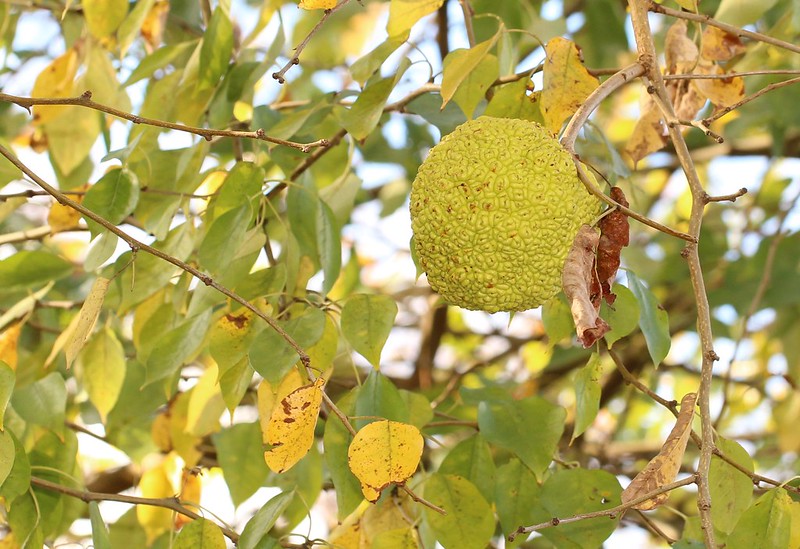Osage Orange
Maclura pomifera (Raf.) C.K. Schneid.
Description
Osage orange is in the mulberry or fig family (Moracceae) and is a medium-sized tree reaching heights of around 35 to 60 feet. Its branches grow into a large, rounded crown that also spreads 35 to 60 feet ¹. The twigs bear short, sharp thorns about 0.5-1 inch long². Osage orange have a has taproot with smaller lateral roots². Its furrowed bark is yellowish-brown 11. Its leaves are lanceolate-ovate shaped, 2½-5 inches long and 1½-2½ inches wide, with long, pointed tips almost resembling a teardrop ³. They exude a milky sap when cut ¹. These trees are dioecious, meaning there are separate male and female trees. While both male and female trees have flowers, only female trees produce a 3 to 5- inch diameter inedible fruit known as a hedge apple¹. Individual fruits are formed from multiple flowers ².

Bark of mature Osage orange. @ J. Robbins (CC BY-NC-ND 4.0), North Carolina Extension ³

Thorn of Osage orange. W. Longbottom (CC BY-NC), Maryland Biodiversity Project 6

Female flower of Osage orange. @ H. Zell (CC BY-SA 3.0), North Carolina Extension ³

Multiple fruit of Osage orange. @ D. Webb* 2019, Maryland Biodiversity Project 6
Distribution
Osage orange can be found throughout most of the United States, mostly residing in the eastern and central states. It is native to the Red River drainage basin of this region, home of the Osage Native American tribe 10. It spanned portions of Texas, Oklahoma, Arkansas and the extreme northwestern corner of Louisiana². The tree prefers medium to dry, well draining soil with full sun to part shade. However, Osage orange is an incredibly sturdy tree with the ability to tolerate wet soils, drought, heat, cold and wind¹. This durability is what has allowed Osage orange to establish itself beyond its native origin. In Maryland Osage orange is currently found throughout the state with the exception of the far eastern and western counties 6.

Original native range of Osage orange 7
Current range of Osage orange 9
Wildlife Importance
While the osage orange fruit is inedible to humans, squirrels and deer often tear into the fruit to consume the pulp and seeds4. The leaves are also an important food source for deer during the spring and summer 4. Additionally, many species of birds enjoy making their nests in the sprawling branches of the Osage orange 4.
Economic Importance
Due to the strength, flexibility, and durability of Osage orange wood, it can be used to produce various goods. Native Americans used the wood for archery bows and other tools, which could be traded for other goods 10. In modern times, Osage orange is mostly utilized for producing fence posts 5. Occasionally, Recently oil from the seeds has been tested as a possible biodiesel and proteolytic enzymes have been discovered in the fruits 7. The wood burns extremely hot with the highest BTU rating of any other North American tree 4. Its heartwood is the most rot-resistant wood of North American hardwoods which led to its use as fence posts 12.
Threats
Osage orange is prevalent and invasive, so it is not under threat of overlogging. It is also quite resistant to pests and diseases². The Osage orange’s only serious threat is cotton root rot, a fungal disease caused by the fungus Phymatotrichum omnivorum².
Interesting Facts
- Today there is no natural dispersal agent for the heavy fruits of Osage orange. It is believed that the Ice Age megafauna such as giant ground sloths and mastodons were responsible for their dispersal 6. Following the demise of that fauna, Osage orange was restricted to the Red River drainage 4.
- Due to its characteristic thorns, Osage orange was planted in rows and kept as short shrubs as a fence before the introduction of barbed wire 9.
- A yellow dye can be extracted from the root bark, which early settlers used to dye cloth 9.
References
- Missouri Botanical Garden: Maclura pomifera
- USDA Forest Service Fire Effects Information Service: Maclura pomifera
- North Carolina Extension: Maclura pomifera
- Wildlife Food for Thought: Osage orange
- J. L. Smith and J. Vf. Perino. 1981. Osage Orange (Maclura pomifera): History and Economic Uses. Economic Botany35: 24-41.
- Maryland Biodiversity Project: Osage orange
- USDA NRCS Plant Fact Sheet: Osage orange
- Wikipedia: Malcura pomifera
- Invasive.org: Osage-orange
- Facts and myths associated with “Hedge Apples”. Iowa State University Extension.
- LadyBird Johnson Wildflower Center: Maclura pomifera
- USDA Forest Service Silvics, Vol. 2, Hardwoods: Maclura pomifera
Contributed by E. McCarthy and S. Plumley
* Image used with permission of photographer.
